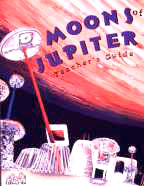Moons of Jupiter
Grades 4—8
Written by Debra Sutter, Cary I. Sneider,
Alan Gould, Carolyn Willard, and Edna De Vore
The journey of the Voyager spacecraft in 1979 took our
collective breath away. Perhaps no exploration since has so
ignited us, or duplicated the mystery and extraordinary beauty
of the newly unveiled Jupiter system.
In this astronomy unit, a contemporary
journey of discovery and astonishment is launched from the moment
students reenact Galileo's 17th-century telescopic observations
of Jupiter's moons. After studying our own Luna, for comparison,
students observe and record Jovian moon orbits over time and
learn why such observations helped signal the birth of modern
astronomy. Students experiment to learn how craters are formed,
make scale models to better understand size and distance, and
take a grand tour of the Jupiter system, as Voyager saw
it.
In the culminating activity, the class works in teams to create
scientific explorers' settlements on each of Jupiter's moons,
using an assortment of common materials. Fascinating background
information is provided on the characteristics of Jupiter and
its moons, and a visibility chart helps teachers plan or assign
Jupiter viewings in the real sky.
A set of overhead transparencies, necessary to recreate
Galileo's telescopic observations of Jupiter and its moons,
must be purchased separately, or you can download the file here as a PDF and print or project it. The set is available through
Carolina Biological Supply Company. To order call 1-800-334-5551
extension 6252.
Comment on this GEMS unit.
|

Order
online
Ordering information
Literature Connections
Spanish Language Student Materials
What materials are needed to present this unit? See the full list. |

